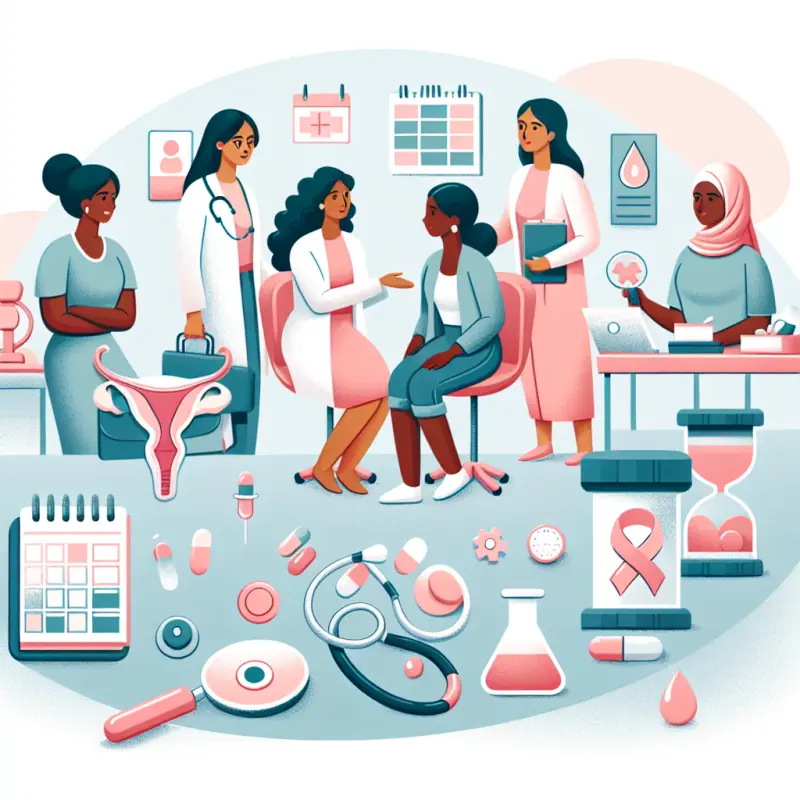STIs and Menstrual Health: What Every Woman Should Know

STIs and Menstrual Health: What Every Woman Should Know
Introduction
In the realm of women's health, understanding the interplay between sexually transmitted infections (STIs) and menstrual health is crucial. Women often navigate a complex landscape of reproductive health issues, and the interaction between STIs and the menstrual cycle can significantly impact both physical and emotional well-being. This article aims to provide comprehensive insights into how STIs can affect menstrual health, the importance of timely diagnosis and treatment, preventive measures, and the role of education in empowering women to take charge of their reproductive health.
Understanding STIs
What are STIs?
Sexually transmitted infections, commonly known as STIs, are infections that are primarily spread through sexual contact. They can be caused by bacteria, viruses, or parasites. Some of the most common STIs include:
- Chlamydia
- Gonorrhea
- Syphilis
- Human Papillomavirus (HPV)
- Herpes Simplex Virus (HSV)
- Human Immunodeficiency Virus (HIV)
- Trichomoniasis
How STIs Affect Women Differently
Women are biologically more susceptible to STIs than men. The reasons include:
- Anatomical Differences: The female genital tract is more exposed and prone to infection.
- Asymptomatic Nature: Many STIs in women do not present symptoms, leading to delayed diagnosis and treatment.
- Long-Term Complications: Untreated STIs can lead to severe reproductive health issues such as pelvic inflammatory disease (PID), infertility, and cervical cancer.
Menstrual Health: A Brief Overview
What is Menstrual Health?
Menstrual health encompasses the physical, social, and psychological aspects of menstruation. It involves the regularity, flow, and symptoms of the menstrual cycle, including pain, mood changes, and overall well-being.
Key Aspects of Menstrual Health
- Regularity: A typical menstrual cycle ranges from 21 to 35 days.
- Flow: Menstrual flow can vary in volume and duration, usually lasting 3-7 days.
- Symptoms: Common symptoms include cramps, bloating, fatigue, and mood swings.
The Interplay Between STIs and Menstrual Health
Impact of STIs on the Menstrual Cycle
STIs can have profound effects on the menstrual cycle, including:
- Irregular Periods: Infections like chlamydia and gonorrhea can cause irregular menstrual cycles due to inflammation and infection of the reproductive organs.
- Increased Pain: STIs can exacerbate menstrual cramps and pelvic pain.
- Abnormal Bleeding: Women with STIs may experience spotting or bleeding between periods.
- Changes in Discharge: Infections can alter the color, consistency, and smell of vaginal discharge.
Long-Term Reproductive Health Complications
Untreated STIs can lead to significant long-term complications:
- Pelvic Inflammatory Disease (PID): A serious infection of the female reproductive organs that can cause chronic pain and infertility.
- Ectopic Pregnancy: An STI-related PID increases the risk of an ectopic pregnancy, a life-threatening condition where a fertilized egg implants outside the uterus.
- Infertility: Chronic untreated infections can lead to scarring and blockages in the fallopian tubes, resulting in infertility.
Diagnosis and Treatment
Importance of Early Diagnosis
Early diagnosis and treatment of STIs are crucial to prevent complications:
- Regular Screening: Women, especially those with multiple sexual partners or those not in monogamous relationships, should undergo regular STI screenings.
- Symptom Awareness: Understanding and recognizing symptoms can lead to earlier diagnosis and treatment.
- Partner Notification: Informing sexual partners is essential to prevent reinfection and further transmission.
Treatment Options
Treatment varies depending on the type of STI:
- Bacterial STIs: These can often be cured with antibiotics. Examples include chlamydia, gonorrhea, and syphilis.
- Viral STIs: While not curable, symptoms can be managed with antiviral medications. Examples include HIV, HPV, and herpes.
- Regular Follow-ups: Post-treatment follow-ups are essential to ensure the infection is cleared and to monitor any long-term effects on reproductive health.
Prevention: Taking Charge of Your Sexual Health
Safe Sex Practices
Practicing safe sex is the most effective way to prevent STIs:
- Condom Use: Consistent and correct use of condoms significantly reduces the risk of STI transmission.
- Vaccinations: Vaccines are available for certain STIs, like HPV and hepatitis B.
- Monogamy: Engaging in a mutually monogamous relationship with a partner who has tested negative for STIs reduces risk.
Regular Health Check-Ups
Regular check-ups and screenings are vital:
- Annual Gynecological Exams: These exams can help detect STIs and other reproductive health issues early.
- Pap Smears and HPV Tests: Regular screenings help in early detection of cervical changes caused by HPV.
Education and Awareness
Empowering women through education is key to prevention:
- Sexual Health Education: Comprehensive education programs that cover STIs and menstrual health are crucial.
- Open Communication: Encouraging open communication about sexual health in relationships promotes awareness and prevention.
Addressing the Psychological Impact
Emotional Well-being
The diagnosis of an STI can be emotionally challenging:
- Stigma and Shame: Societal stigma can affect a woman's self-esteem and mental health.
- Support Systems: Access to counseling and support groups can help women cope with the emotional impact of STIs.
Building Resilience
Developing resilience is essential for managing both STIs and menstrual health challenges. Building resilience involves:
- Seeking Support: Reach out to trusted friends, family, or support groups to share your experiences and feelings.
- Accessing Professional Help: Consider counseling or therapy to address emotional distress and develop coping strategies.
- Educating Yourself: Understanding STIs and menstrual health can reduce fear and empower you to make informed decisions.
- Practicing Self-Care: Prioritize your physical and mental well-being through healthy habits, stress management, and self-compassion.
Conclusion
STIs can have a significant impact on menstrual health and overall well-being, but with knowledge, prevention, and support, women can take charge of their sexual health. Regular screenings, safe sex practices, and open communication with healthcare providers and partners are key to prevention and early intervention. Remember, you are not alone—resources and support are available to help you navigate both the physical and emotional aspects of STIs and menstrual health. If you have concerns or questions, consult a healthcare professional for personalized advice and care.